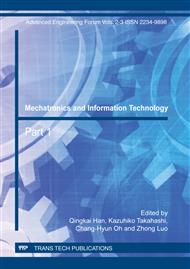[1]
DeajeunMuneun. Dosul Dongyang medicine, Nonjang: (1992).
Google Scholar
[2]
Whan Kim, Oriental Medicine principle, SungBo: (1990).
Google Scholar
[3]
ChanMin Kim, Sasang constitutional medicine, Academi: (2002).
Google Scholar
[4]
T. Yamamoto and Y. Yamamoto, Electrical properties of the epidermal stratum corneum, Med. Biol. Eng., Vol. 14, pp.151-158, (1976).
DOI: 10.1007/bf02478741
Google Scholar
[5]
T. Yamamoto, Y. Yamamoto and T. Ozawa, Characteristics of skin admittance fot dry electrodes and the measurement of skin moisturization, Med. Biol. Eng. Comput., Vol. 24, pp.71-77, (1986).
DOI: 10.1007/bf02441608
Google Scholar
[6]
J. Rosell, J. Colominas, P. Riu, R. Pallas-Areny and J.G. Webster, Skin impedance from 1Hz to 1MHz, IEEE Trans. biomed. Eng., Vol. 35, pp.649-651, (1988).
DOI: 10.1109/10.4599
Google Scholar
[7]
D. Panescu, K.P. Cohen, J.G. Webster and R.A. Stratbucker, The mosaic electrical characteristics of the skin, IEEE Trans. Biomed. Eng., Vol. 40, pp.434-439, (1993).
DOI: 10.1109/10.243418
Google Scholar
[8]
SoonYong Chun, UnHo Ji, H. Troy Nagle, Observations of the current change on acupuncture spots at the meal time, IEEE CBMA204, 59, (2004).
Google Scholar
[9]
SoonYong Chun, UnHo Ji, Design for a Conductivity Measurement System, Korea IEEK, (2009).
Google Scholar
[10]
D. Panescu, J.G. Webster and R.A. Stratbucker, A nonlinear electrical-thermal model of the skin, IEEE Trans. Biomed. Eng., Vol. 41, pp.672-679, (1994).
DOI: 10.1109/10.301734
Google Scholar
[11]
S.J. Dorgan and R.B. Reilly, A model for human skin impedance during surface functional neuromus-cular stimulation, IEEE Trans. Rehab. Eng., Vol. 7, pp.341-348, (1999).
DOI: 10.1109/86.788470
Google Scholar
[12]
P.T. Kolen, Transformer miniaturization for trans-cutaneous current/voltage pulse applications, IEEE Trans. Biomed. Eng., Vol. 46, pp.606-608, (1999).
DOI: 10.1109/10.759061
Google Scholar
[13]
Korea institute of Oriental Medicine, Research of meridian system I, Korea institute of Oriental Medicine: (1996).
Google Scholar
[14]
Nakatani, Y. On the nature of the acupuncture points and meridians: J. Jap. Orient. Med. 3, 1953: 39~49.
Google Scholar
[15]
Haiso Yu-san. Meridians as enisaged from the study of skin conductance: J. Chin, Traditional Med. Feb., 1958: 1~8.
Google Scholar
[16]
John Enderle, Biomedical Engineering, Elsevier, (2005).
Google Scholar


